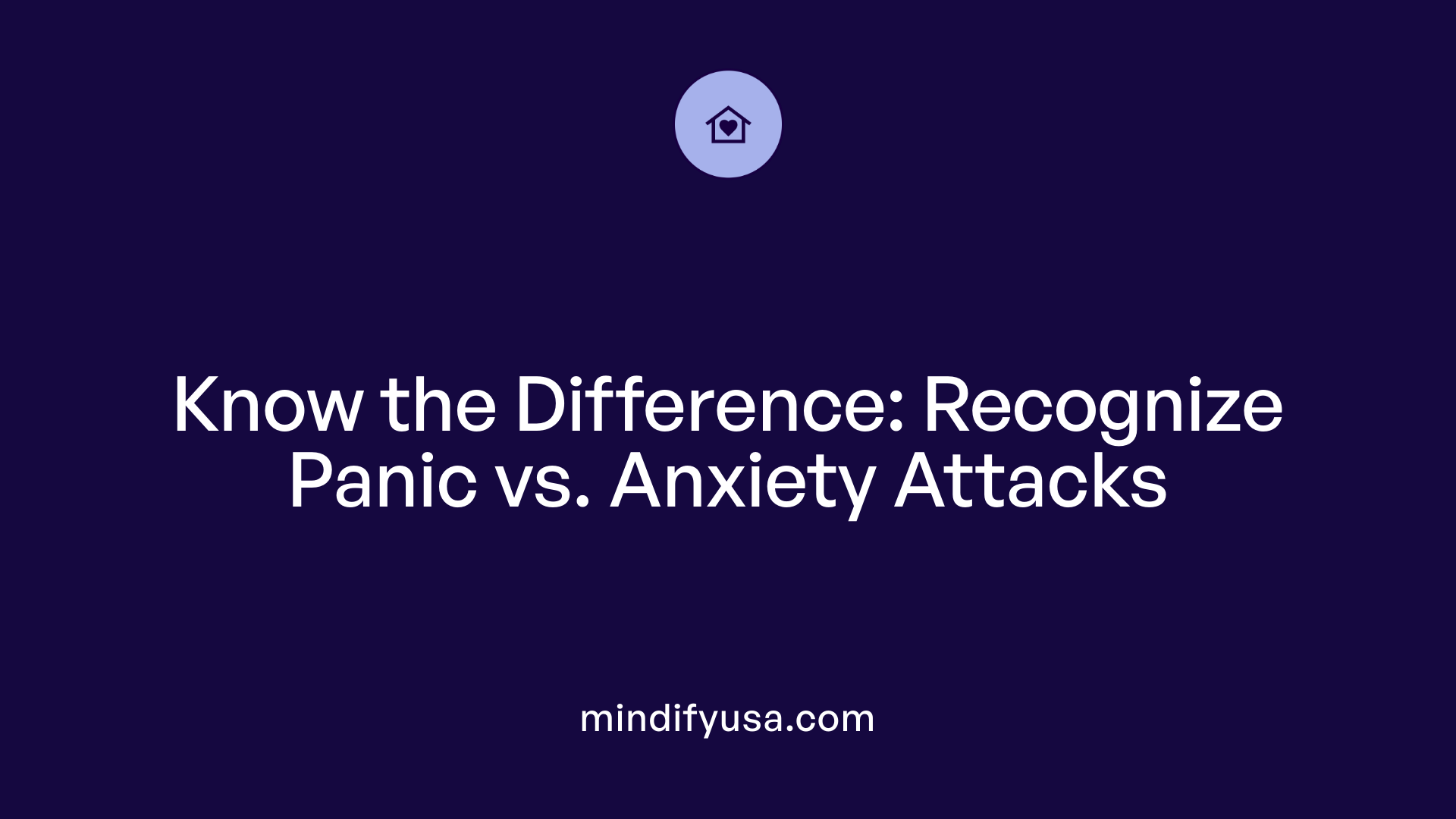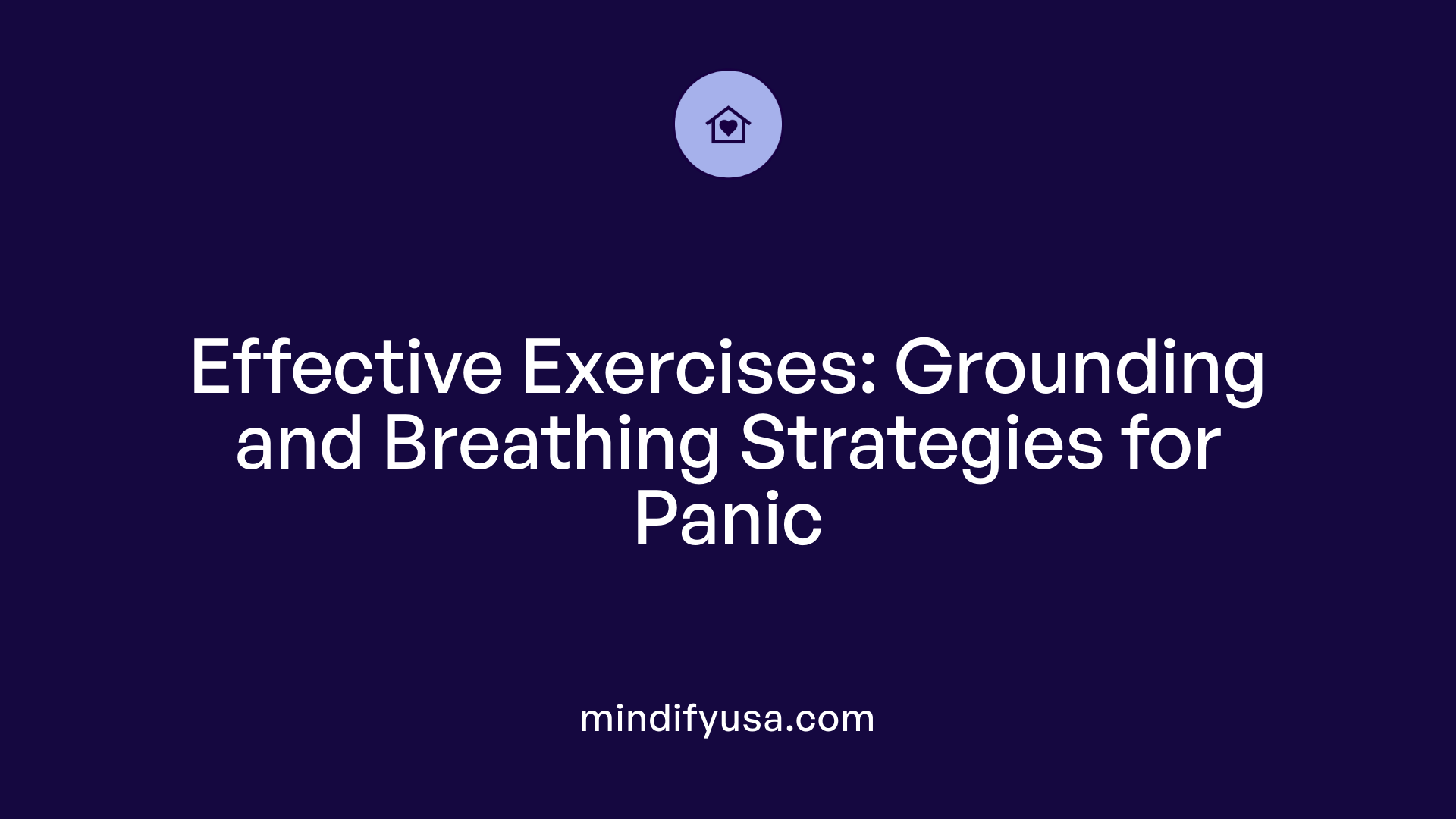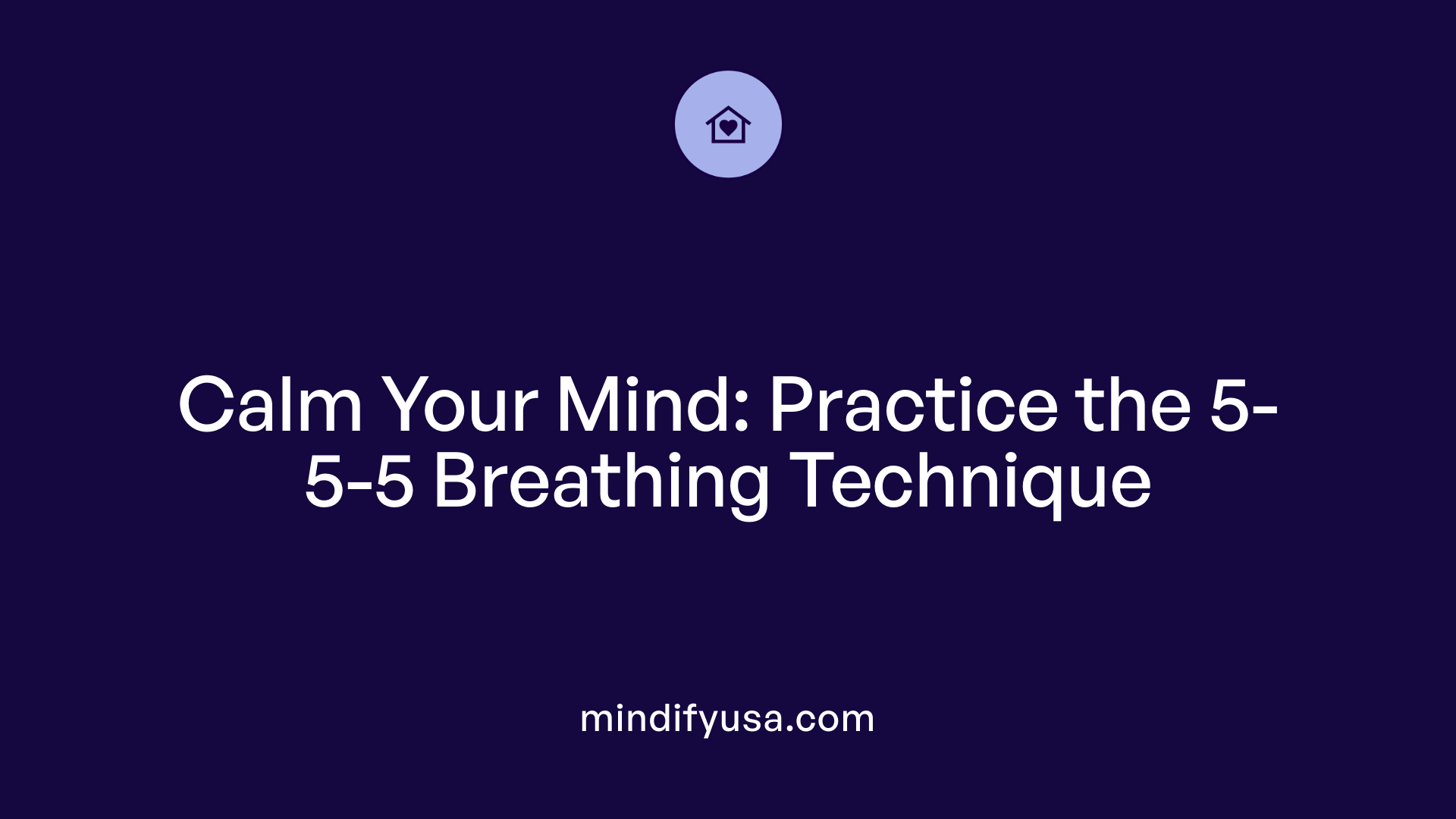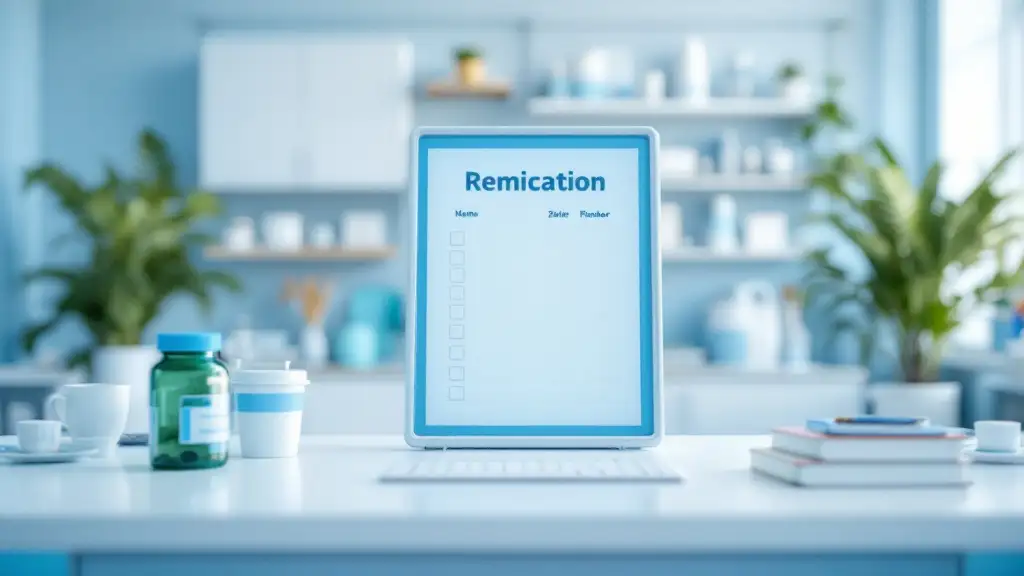Understanding Panic and the Promise of Guided Therapy
Panic attacks can strike suddenly and intensely, leaving individuals feeling overwhelmed and frightened. While these episodes can be distressing, managed with the right therapeutic approaches, they become more controllable. Guided therapy, particularly through evidence-based techniques such as cognitive-behavioral therapy (CBT), mindfulness, and meditation, offers a structured pathway toward relief and resilience. This article explores the nature of panic attacks, effective therapeutic techniques, and practical exercises designed to empower individuals in managing their symptoms.
Differentiating Between Panic and Anxiety Attacks

What is the difference between a panic attack and an anxiety attack?
Panic attacks and anxiety attacks are often confused, but they have distinct characteristics that set them apart. A panic attack is a sudden, intense episode of fear that usually reaches its peak within minutes. It involves physical symptoms such as a racing heartbeat, shortness of breath, dizziness, shaking, sweating, and feelings of dread or imminent danger. These attacks often occur unexpectedly, without a clear trigger, and can be quite overwhelming.
In contrast, an anxiety attack, sometimes called an anxiety episode, tends to develop gradually in response to identifiable stressors or worries. It is usually less intense physically but can last longer—sometimes hours or even days. Symptoms include tension, worry, restlessness, and physical sensations like muscle tension or mild breathlessness. Unlike panic attacks, anxiety episodes are more persistent and often related to ongoing concerns or situations.
Understanding these differences is crucial for seeking appropriate help and treatment. While panic attacks are characterized by their sudden onset and intense physical symptoms, anxiety tends to develop over time, with symptoms more closely tied to external stressors.
Both conditions can be managed effectively with techniques such as cognitive behavioral therapy (CBT), grounding exercises, breathing retraining, and mindfulness practices. Recognizing whether you are experiencing a panic or anxiety attack helps tailor coping strategies and improves overall treatment outcomes.
Therapeutic Techniques for Effective Management
What therapeutic techniques are effective for managing panic attacks?
Managing panic attacks effectively involves a mix of psychological strategies and lifestyle adjustments. Cognitive-behavioral therapy (CBT) stands out as a highly effective approach. It helps individuals recognize and challenge unhelpful thoughts that escalate panic symptoms, such as fears of losing control or dying. Through structured sessions and exercises, people learn to reframe these thoughts and develop healthier coping mechanisms.
Mindfulness and relaxation methods are also central in managing panic episodes. Techniques like deep breathing exercises, meditation, and grounding practices, such as the '5-4-3-2-1' technique, help individuals stay anchored in the present moment. These practices activate the body's relaxation response, counteracting the 'fight or flight' reaction and reducing the severity of symptoms.
Breathing exercises can be particularly useful during an attack. Slowing down to five breaths per minute can help control hyperventilation, easing symptoms like dizziness and shortness of breath. Meditation, especially mindfulness-based approaches, encourages focus on physical sensations and calming thoughts, which can prevent panic from escalating.
Lifestyle modifications also play a vital role. Maintaining a healthy diet, avoiding caffeine, alcohol, and cigarettes, and engaging in regular physical activity can lower overall anxiety levels. Managing stress through activities like yoga, Pilates, or walking can further improve emotional well-being.
In some cases, professional support may include medication, prescribed by a healthcare provider, especially if symptoms are severe or persistent. Support groups, such as Anxiety UK or Mind, offer additional comfort and shared experiences that can empower individuals.
By combining these approaches—psychological therapies like CBT, mindfulness techniques, physical health routines, and professional support—people can better manage and even reduce the frequency of panic attacks, leading to a more balanced and less fearful life.
Practical Exercises: Grounding and Breathing Strategies

What are some practical exercises and strategies to reduce panic episodes?
Managing panic attacks involves using specific exercises designed to calm the body and mind. One of the most accessible techniques is grounding, which helps anchor you in the present moment and divert attention from distressing symptoms.
The 5-4-3-2-1 method is a popular grounding exercise. It requires identifying five things you see around you, four you hear, three you feel (such as textures or temperature), two you smell, and one you taste. This sensory-awareness activity shifts focus away from panic sensations, making it easier to regain control.
Controlled breathing is another vital strategy. The 5-5-5 rule involves inhaling slowly through the nose for five seconds, holding the breath for five seconds, and then exhaling gently through the mouth for five seconds. Repeating this pattern stabilizes the breathing rate, reduces hyperventilation, and signals your nervous system to relax.
Physical grounding activities can also help. Walking barefoot on grass or sand provides tactile feedback that reconnects you with your environment. Holding a comforting object, like a stone or a piece of fabric, can also serve as a tangible focus during overwhelming moments.
Embedding mindfulness into daily routines enhances overall resilience against panic. Gentle stretching, progressive muscle relaxation, and brief meditation sessions reinforce emotional regulation.
Incorporating these exercises regularly can decrease the intensity and frequency of panic episodes, empowering individuals with tools to manage symptoms effectively when they arise.
The Grounding Technique: 5-4-3-2-1 Method
Step-by-step approach
The 5-4-3-2-1 grounding technique is a simple yet powerful method used to help individuals manage panic attacks by anchoring them to the present moment. It involves a series of steps where you consciously focus on your senses to redirect your attention away from distressing thoughts or physical sensations of panic.
Begin by calmly observing your environment. First, identify and acknowledge five things you can see around you. Then, focus on four things you can touch or feel, paying attention to textures or temperature. Next, listen carefully for three sounds, such as birdsong, traffic, or your own breathing. After that, notice two smells; these could be pleasant scents like coffee or flowers or neutral smells in your surroundings. Lastly, find one thing you can taste or imagine tasting, like a mint or a sip of water.
This structured approach helps to ground you by engaging your senses in a focused and deliberate way. It’s a manageable activity that can be performed anywhere, at any time, making it a convenient tool for panic management.
Sensory focus points
Each step of the 5-4-3-2-1 method revolves around sensory focus points, which are crucial for shifting attention away from overwhelming thoughts. Examples include:
- Seeing: The color of a pillow, a passing car, a plant.
- Touching: The fabric of your clothing, a smooth surface, your own hand.
- Hearing: Music, footsteps, distant sirens.
- Smelling: Freshly baked bread, scented candles, your perfume.
- Tasting: The taste of gum, or imagining the flavor of a favorite food.
Focusing on these senses helps to activate the brain’s relaxation response, reducing the intensity of panic symptoms.
Impact on nervous system
The primary effect of the 5-4-3-2-1 technique is calming the nervous system by stimulating the parasympathetic branch, which promotes relaxation. When you concentrate on sensory inputs, you interrupt the hyperactive fight-or-flight response triggered during panic attacks. This mindful engagement slows down your heart rate, reduces muscle tension, and diminishes feelings of dread.
Research and clinical experience suggest that regular practice of grounding techniques improves overall emotional regulation. Over time, individuals can better handle stress and lessen the frequency or severity of panic episodes. This method serves as a practical, accessible way to re-establish a sense of control whenever panic symptoms arise.
Controlled Breathing: The 5-5-5 Rule
 The 5-5-5 breathing rule is a simple and effective technique to help manage panic attacks by regulating breathing and calming the nervous system.
The 5-5-5 breathing rule is a simple and effective technique to help manage panic attacks by regulating breathing and calming the nervous system.
The pattern involves inhaling slowly through the nose for 5 seconds, holding the breath for an additional 5 seconds, and then exhaling slowly through the mouth for 5 seconds. This controlled breathing pattern encourages slower, deeper breaths, which can counteract the rapid, shallow breathing often experienced during a panic attack.
Physiologically, this breathing technique helps reduce hyperventilation and stabilizes carbon dioxide levels in the blood. As a result, it decreases symptoms such as dizziness, lightheadedness, and feelings of breathlessness. Additionally, the deliberate pace seen in the 5-5-5 method signals to the brain that it is safe, helping to diminish the body’s stress response and promote relaxation.
The 5-5-5 rule is especially useful during moments when anxiety or symptoms of panic are escalating. It can be employed in various situations, such as before a stressful event, during a panic attack, or whenever feeling overwhelmed. Consistent practice can also strengthen your overall capacity to manage anxiety and reduce the frequency of panic episodes.
Incorporating this technique as part of a broader suite of calming strategies — including grounding, mindfulness, and meditation — can greatly improve emotional regulation and resilience. For prolonged or recurrent panic attacks, consulting with a healthcare professional remains an important step to ensure comprehensive care.
Therapeutic Options and Medications in Context
What are some common therapeutic options to help manage panic attacks?
Managing panic attacks involves a combination of different approaches. Cognitive-behavioral therapy (CBT) is a primary treatment, focusing on helping individuals recognize and challenge unhelpful thoughts that trigger panic. It often includes exposure techniques, where patients gradually confront situations or sensations that provoke anxiety, reducing their power over time.
In addition to therapy, medications can play a role. Selective serotonin reuptake inhibitors (SSRIs) and serotonin-norepinephrine reuptake inhibitors (SNRIs) are prescribed to help balance brain chemistry and prevent attacks. Benzodiazepines may be used for short-term relief, especially during acute episodes, but are generally recommended with caution due to potential dependency.
Lifestyle changes are equally important. Regular physical activity, maintaining healthy eating habits, avoiding stimulants like caffeine and alcohol, and ensuring enough sleep help lessen the brain’s vulnerability to panic episodes. Stress management tools such as mindfulness, deep breathing, and progressive muscle relaxation are effective both in preventing and coping with attacks.
Immediate relief strategies during a panic attack include grounding techniques, such as the 5-4-3-2-1 method, which involves focusing on sensory experiences to reorient oneself, and controlled breathing exercises to slow hyperventilation.
Overall, a tailored plan combining therapy, medications, and lifestyle modifications tends to be most effective in reducing panic attack frequency and severity. Education about panic symptoms and ongoing support further enhance treatment success.
The Impact of Brain Structures and Stressors
What is the biological basis of panic attacks?
Panic attacks originate from specific areas within the brain that handle fear and threat detection. Key players include the amygdala and the frontal lobe.
The amygdala functions as the brain's alarm system. It rapidly detects perceived threats and activates the body's fight, flight, or freeze response. During a panic attack, the amygdala can become hyperactive or misinterpret harmless physical sensations as danger, triggering intense fear and physical symptoms.
The frontal lobe plays a crucial role in assessing and interpreting these signals. It helps regulate emotional responses and exerts control over reactions initiated by the amygdala. When the connection between these regions is disrupted, or when they respond excessively to benign stimuli, a panic attack can occur.
Various triggers, such as stressful life events, high anxiety levels, physical exertion, or substance use, can influence these brain regions. They may lead to increased activity or miscommunication between the amygdala and the frontal lobe, resulting in the sudden onset of symptoms.
Understanding this biological mechanism sheds light on why panic attacks happen and reassures that they are not physically dangerous. Instead, they are overreactions of a normally functioning threat detection system that has become overly sensitive.
This knowledge underscores the importance of managing stress and understanding physiological responses. Using techniques like breathing exercises, grounding, and cognitive techniques can help soothe these brain responses and reduce the severity and frequency of panic episodes.
Lifestyle and Support: Building Resilience and Seeking Help

What lifestyle factors support the management of panic attacks and when should professional help be sought?
Managing panic attacks involves more than just therapy techniques. Lifestyle choices can significantly influence how often and intensely panic episodes occur.
Maintaining healthy habits like balanced eating, regular physical activity, and getting enough sleep are fundamental. These practices help regulate the body's stress response and reduce the likelihood of triggers. Avoiding stimulants such as caffeine, alcohol, and cigarettes also minimizes physiological arousal that can provoke panic.
In addition, practicing mindfulness and stress management strategies strengthens emotional resilience. Techniques like breathing exercises, grounding, and regular mindfulness meditation can diffuse anxious feelings before they escalate into full-blown panic.
Recognizing when to seek urgent help is vital. If panic attacks happen frequently or become severe—especially if accompanied by chest pain, dizziness, or thoughts of self-harm—it’s important to consult a healthcare professional promptly. Such symptoms could indicate an underlying medical condition or require specialized mental health support.
Support networks are also beneficial. Community groups and organizations like Anxiety UK or Mind offer peer support and shared experiences, which can help reduce feelings of isolation.
Seeking professional diagnosis and personalized treatment plans, which may include therapy, medication, or both, ensures comprehensive care. Regular follow-ups help adjust strategies to effectively manage panic disorder.
Overall, blending healthy lifestyle choices with timely professional help creates a strong foundation for managing panic attacks and improving mental wellbeing.
Empowering Through Understanding and Practice
Managing panic attacks effectively requires a combination of education, structured therapeutic approaches, and consistent self-help exercises. Guided therapy, especially CBT and mindfulness practices, offers empowering tools to understand the physical and psychological aspects of panic episodes. By recognizing triggers, practicing grounding and breathing exercises, and seeking professional support when needed, individuals can reduce their reliance on avoidance behaviors and improve their quality of life. Remember, help is available, and with patience and persistence, overcoming panic is an achievable goal.
References
- Panic self-help guide - NHS inform
- 5-4-3-2-1 Coping Technique for Anxiety - UR Medicine
- Panic Disorder Self-Help Resources - Centre for Clinical Interventions
- How to Treat Panic Attacks: 6 Exercises and Techniques
- Panic attacks: Recognizing and managing panic ... - Harvard Health
- Meditation for Panic Attacks | Charlie Health
- How to Manage Panic Attacks With Meditation - Verywell Mind






































































































